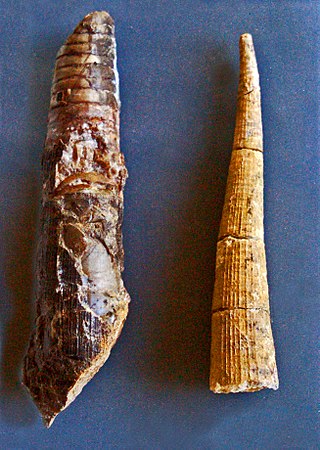Related Research Articles
Megasphaeroceras is an ammonite genus included in Sphaeroceratidae, a family of ammonoid cephalopods characterized by their spheroidal shells with markedly eccentric coiling, fine ribbing, and complex sutures, known from the Bajocian.
Paraloxoceras is a genus of straight shelled, orthoconic nautiloid cephalopods, now extinct, that lived during the Early Carboniferous. Fossils have been found in Europe and central Asia; the type, P. konincki, named by Flower, came from Belgium.
Franklinoceras is an extinct gensu of cephalopods from the nautiloid order, Discosorida. Nautiloids comprise a subclass of shelled cephalopods that were once diverse and numerous but are now represented by only a handful of species.
Octamerella is an extinct genus of prehistoric nautiloids from the oncocerid family Hemiphragmoceratidae that lived in what is now Europe and North America during the Middle Silurian.
Jovellania is a genus of extinct prehistoric nautiloids from the order Oncocerida known from the Lower Devonian of Europe. Nautiloids form a broad group of shelled cephalopods that were once diverse and numerous but are now represented by only a handful of species in two genera.

Kionoceras is an extinct nautiloid cephalopod genus included in the orthocerid family Kionoceratidae with scattered worldwide distribution from the Middle Ordovician to the Lower Permian. Kionoceratids are orthocerids with prominent longitudinal ornamentation on their shells, sometimes augmented by secondary transverse ornamentation. Orthocerids are, of course, prehistoric nautiloides with generally straight and elongate shells, mostly with central or subcentral siphuncles.
The Genus Hemichoanella is a small, extinct, orthoconic nautiloid cephalopod from the Lower Ordovician of Western Australia assigned to the orthoceratoid family, Baltoceratidae. Hemichoanella and the Baltoceratidae are part of the subclass of once diverse and numerous shelled cephalopods known as the Nautiloidea.
Hoeloceras is an extinct orthoconic nautiloid cephalopod from the upper Ordovician, generally included in the Actinocerida. Nautiloids are a subclass of shelled cephalopods that were once diverse and numerous but are now represented by only a couple of genera, Nautilus and Allonautilus.
Brevicoceras is an extinct nautiloid genus from the order Oncocerida with wide distribution in the Middle Devonian in Eastern North America, Russia and Morocco. Nautiloids form a broad group of shelled cephalopods that were once diverse and numerous but are now represented by only a handful of species in two genera.
Neocycloceras is an extinct genus of nautiloid included in the Pseudorthocerida that lived during the Late Devonian and Mississippian. Neoclycloceras is characterized by a slender, generally circular shell with slightly oblique, sinuous surficial annulations. Its sutures have dorsal and ventral saddles and lateral lobes and become more oblique with age. Saddles point forward, lobes to the rear. Dorsal saddles are broad and low but the ventral ones are high and conspicuous. The siphuncle is located between the center and venter and is nummuloidal, composed of rounded expanded segments, the inside of which contains a continuous laminar lining that is thickest in the middle of the segments and thinnest at the septal necks. Neocycloceras has been found in Pennsylvania in North America and in Morocco in north Africa.
Winnipegoceras is an extinct nautiloid genus from the Ordovician belonging to the Order Discosorida.
Tetrapleuroceras is an extinct prehistoric nautiloid from the Lower Permian of the Urals in Russia. Nautilids are a type of nautiloid, a subclass of shelled cephalopods that were once diverse and numerous but now only represented by Nautilus and Allonautilus
Westonoceras is an extinct nautiloid genus from the Discosorida that lived during the Middle and Late Ordovician that has been found in North America, Greenland, and Northern Europe. It is the type genus for the Westonoceratidae
Stearoceras is an extinct genus of prehistoric nautiloids from the Lower Pennsylvanian - Lower Permian with a fair worldwide distribution.(Kümmel 1964)
Endorioceras is an extinct genus of actively mobile carnivorous cephalopod of the family Baltoceratidae that lived in what would be North America during the Ordovician from 490–479 mya, existing for approximately 11 million years.
Geisonocerina is an extinct genus from the carnivorous nautiloid cephalopod order Orthocerida that lived in what would be North America, Europe, and Asia during the Ordovician through Permian from 449 to 290 mya, existing for approximately 159 million years.
Hemicosmorthoceras is an extinct genus of actively mobile carnivorous cephalopod, essentially a Nautiloid, that lived in what would be present day Europe during the Silurian to Devonian from 422.9—412.3 mya, existing for approximately 10.6 million years.
Neosichuanoceras is an extinct genus of actively mobile carnivorous cephalopod, essentially a Nautiloid, that lived in what would be Asia during the Silurian from 436.0 to 428.2 mya, existing for approximately 7.8 million years.
Paradnatoceras is an extinct straight-shelled cephalopod genus that lived in what would become China during the Ordovician from 478.6 to about 461 mya, existing for approximately 17.6 Ma.
Protobactrites is an extinct nautiloid cephalopod belonging to the Orthoceratoidea that lived in what would be Europe and Asia during the Ordovician and Silurian from 466–421.3 mya, existing for approximately 44.7 million years.
References
- ↑ PaleoBiology Database: Donacoceras, basic info
- ↑ C. Teichert, B. Kummel, W.C. Sweet, H.B. Stenzel, W.M. Furnish, B.F. Glenister, H.K. Erben, R.C. Moore, and D.E. Nodine Zeller. 1964. Cephalopoda - general features - Endoceratoidea - Actinoceratoidea - Nautiloidea - Bactritoidea. Treatise on Invertebrate Paleontology K(3):1-519
- ↑ J. J. Sepkoski. 2002. A compendium of fossil marine animal genera. Bulletins of American Paleontology 363:1-560